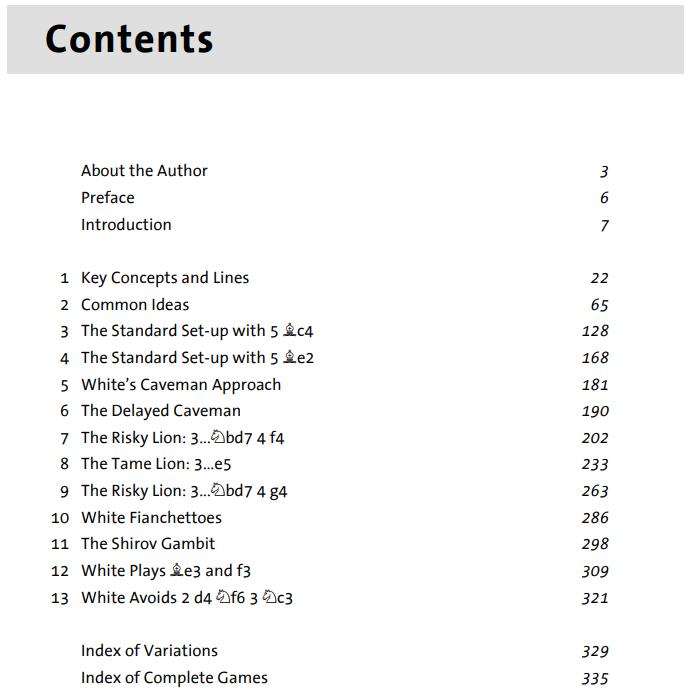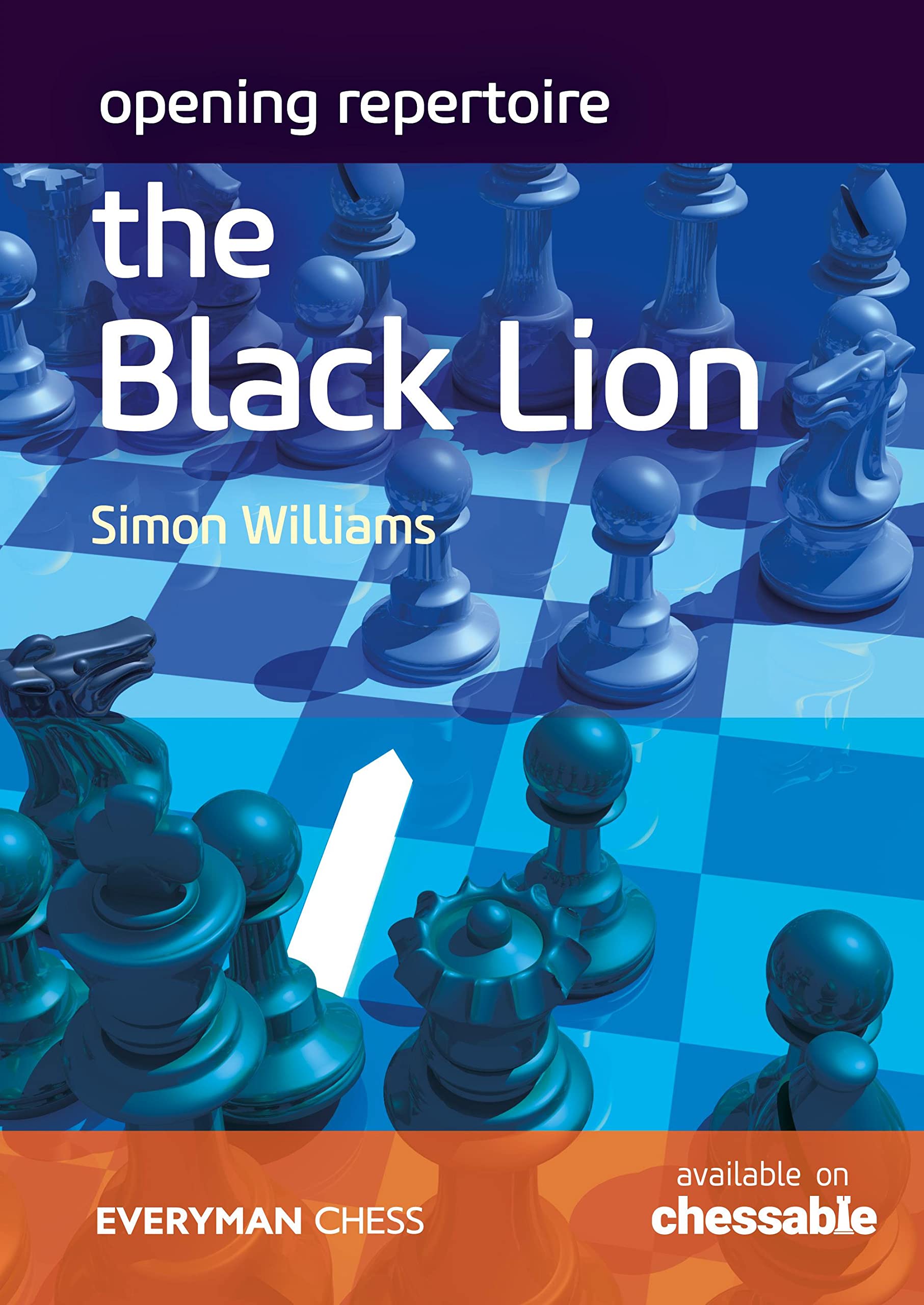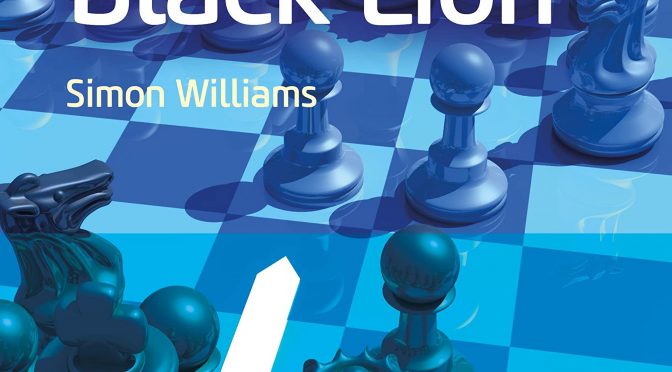Here is the publishers blurb from the rear cover :
“The Black Lion is a thoroughly modern counterattacking system that is a nightmare to face. This wild and aggressive line attempts to take away White’s initiative from a very early stage and is guaranteed to throw your opponents off balance.
The Black Lion is essentially a contemporary and aggressive interpretation of the Philidor Defence (1 e4 e5 2 Nf3 d6). The Black Lion starts with a slightly different move order, 1 e4 d6 2 d4 Nf6 3 Nc3, and now the lion family splits into two different animals: the risky lion (3…Nbd7) or the tame lion (3…e5). Both treatments are thoroughly investigated in this book.
Simon Williams (the Ginger GM) is the ideal guide to explain how to whip up an extremely dangerous attack using either treatment. Williams is well known for his swashbuckling, attacking play and the Black Lion suits his style perfectly. His commentary and annotations are always instructive and entertaining. * The Black Lion is an unusual and dangerous system with little established theory. * White cannot rely on simple, safe moves as such a strategy is liable to be overrun. * The Black Lion is fun and exciting to play!”
About the author:

“Simon Williams is a Grandmaster, a well-known presenter and a widely-followed streamer, as well as a popular writer whose previous books have received great praise. He is much admired for his dynamic and spontaneous attacking style.”
As with every recent Everyman Chess publication high quality paper is used and the printing is clear. Each diagram is clear as is the instructional text. Figurine algebraic notation is used throughout. The usual and reliable formatting from Brighton-based typesetter IM Byron Jacobs is employed.
The diagrams do not have a “to move” indicator or any kind of caption so you will need to work out for yourself how they relate to the text that they are embedded in. However, this is fairly obvious.
There is a helpful Index of Variations and an Index of completed games.
The table of contents is:

Before we continue it is worth taking a look at the pdf extract which includes the Contents, Preface and pages 128 – 141.
(One thing to note is that despite being published in August 2022, the most recently played cited games are dated from 2019 and, essentially, we have a Chessable course migrated into physical book form. I can’t imagine that this task was straightforward for editor IM Richard Palliser.)
Overall, this book offers a repertoire for Black (against 1.e4 essentially but 1.d4 d6 2.e4 Nf6 could transpose of course) after White has played 3.Nc3 as follows:
and from here on in offering Black the choice of two main continuations which are closely related but which Black can make distinctly different.
We have
which most would characterise as The Modern Philidor rather than a Black Lion (so named in the wonderful The Black Lion: The Chess Predator’s Choice Against Both 1.e4 and 1.d4 by Jerry Van Rekom and Leo Jansen (New in Chess, 2008).
Alternatively Black can essay the more provocative
The Black Lion and Modern Philidor diverge based on what Black does with the Queen’s knight. If Black castles short and leaves the knight on d7 (initially) then we probably have a Modern Philidor. Deferring castling, re-routing the d7 knight to f8, playing h6 and g5 and then the knight goes to g6 and then f4 really is The Black Lion proper.
Anyway, enough of my pedantic nomenclature rambling…
As implied the transpositional possibilities are numerous so organising the material cannot have been easy. One thing to note is that the author advocates 5…Be7 in the main line which is a move order improvement over the older 5…h6 Lion move order. The Introduction lays out the ‘philosophy’ of the approach clearly differentiating the 3…e5 and 3…Nbd7 choices and together with early games provides background knowledge for those new to this …d6 dark square system.
Chapter One: Key Concepts and Lines essentially clothes the skeleton created by the Introduction and includes ideas such as the once feared Shirov Attack:
which is detailed in Chapter 11.
Chapter Two: Common Ideas is the first real exposé of the key Lion idea and spends pages 65 – 128 and 14 full games detailing the really quite profound idea of rerouting the d7 knight to f4. Anyone new to the Lion should study this chapter carefully before moving on.
Chapter Three: The Standard Set-up with Bc4 takes as its starting position
in which Black has deferred castling to allow the knight relocation manoeuvre.
Chapter Four: The Standard Set-up with 5.Be2 allocates twelve pages on a line that probably will never be seen by most second players but will be of interest nonetheless.
A consequence of the move order advocated in Chapter three is that White may attempt various ‘capturing on f7 type hacks’ and these are treated in detail in Chapters Five and Six.
Arguably the most obvious attempt to refute the 3…Nbd7 move order is the aggressive 4.f4 dealt with in Chapter Four: The Risky Lion: 3…Nbd7 4 f4
and then …e5
As indicated Black may chose to go down the “Modern Philidor” (although the author refers to this as “The Tame Lion) route as in Chapter Eight with
covering in detail the queenless middlegame variations. The more common White choice of 4.Nf3 is assumed to be covered elsewhere such as Chapters Three to Six, or is it…?
Coverage is completed with Chapters on various g4 ideas by White plus insipid ideas such as g3 and f3.
In summary, The Black Lion is a welcome take on an increasingly popular dark square defence to 1.e4 with the accent on the trademark knight manoeuvre and deferred castling providing many lessons learnt from the 2008 book which introduced the idea.
I would argue that a chapter is missing on the so-called Tame Lion / Modern Philidor move order making Qc7 less desirable and I am thinking of
arising from a typical move order such as 1.e4 d6 2.d4 Nf6 3.Nc3 e5 4. Nf3 Nbd7 5.Bc4 Be7 6.00 00 7.a4 c6 which has 3465 games in MegaBase 2023. No doubt the author will argue that this position where White has tried around 20 (!) different 8th moves deserves an entire book in its own right and I would agree with that.
As a consequence of the migration of the contents from Chessable course to book (which cannot have made life easy for the editor!) there is degree of repeated déjà vu as one reads the same comments. Presumably this is measure of the Chessable philosophy of learning through reinforcement and would not normally happen in a “normal” physical book.
Bearing in mind my earlier comments regarding 2019 this book is a valuable addition to opening literature. Enjoy!
John Upham, Cove, Hampshire, 19th February, 2023

Book Details :
- Paperback : 336 pages
- Publisher: Everyman Chess (22 August 2022)
- Language: English
- ISBN-10:1781946280
- ISBN-13:978-1781946282
- Product Dimensions: 17.3 x 1.7 x 23.8 cm
Official web site of Everyman Chess


